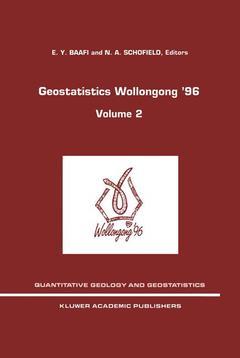Description
Geostatistics Wollongong’ 96, 1997
Volume 2
Quantitative Geology and Geostatistics Series, Vol. 8
Language: English
Subjects for Geostatistics Wollongong’ 96:
Keywords
Publication date: 11-2012
665 p. · 16x24 cm · Paperback
665 p. · 16x24 cm · Paperback
Description
/li>Contents
/li>Comment
/li>
In diamond alluvial deposits, the information about the spatial distribution of stone size is of crucial importance for the quantitative characterisation of the different areas of the deposit. In fact, the value of the diamond reserves depends strongly on the distribution of stone sizes: between two areas with the same grade, the most valuable is the one with larger stones. The geological genesis of the mineralization, related with the transport and deposition of stones in trapsites, can create separated spatial areas, corresponding to different stone size. To characterise these distinct areas, the non smooth transitions between them should be accounted for, in the estimation of internal properties. An extended version of zonal control of geostatistical estimation (Soares et ai, 1995) proposed in this paper, aims to characterising the classes of size histogram for each geological unit, avoiding the smooth effect. For this purpose the morphology of each geological unit is obtained by using two distinct criteria: i) first, the points of each unit are classified according to the local and global probabilities of belonging to each unit (Soares, 1992); ii) in a second classification, the optimization technique of Simulated Annealing is used to rearrange the pre-classified points in order to impose, in the final morphological maps, the spatial variability of experimental samples (Goovaerts, 1994). A case study of a diamond alluvial deposit with two geological units with distinct stone size histograms is presented.
Mining.- Structural Controls in the Geostatistical Simulation of Mineral Deposits.- Zonal Control to Estimate Classes of Histograms: Application to a Diamond Alluvial Deposit.- A Geostatistical Conditional Simulation Algorithm that Exactly Honours a Predefined Grade-Tonnage Curve.- The Conditional Simulation of a Cox Process with Application to Deposits with Discrete Particles.- Geostatistical Conditional Simulation of a Large Iron Orebody of the Pilbara Region in Western Australia.- Simulation of Weathered Layers in a Granite Massif Based on Geophysics Survey.- Option Pricing: Estimation Versus Simulation for Brennan & Schwartz Natural Resource Model.- The Valuation of the Target Project.- Geostatistics Applied to the Monte Carlo Analysis of Mining Projects.- Classification on a Complex Orebody: A Geostatistical Approach.- Sampdril.- Choosing an Exploration Drillhole Spacing: A Case Study in an Iron Mine.- Making Maximum Use of Limited Sampling Data from Deep Boreholes: Verification Techniques.- A Practical Analysis of the Effects of Spatial Structure and of Data Available and Accessed, on Conditional Biases in Ordinary Kriging.- Change of Support and Use of Economic Parameters for Block Selection.- Geostatistics for Contouring Net-Worth Value of Coal Deposits.- Application of Cokriging in Iron Ore Evaluation: Iron Ore Quadrangle — Brazil.- Ore Reserve Estimation of Alluvial Diamond Deposits.- Selectivity Studies on Multivariables under Constraint in an Indian Iron Ore Deposit.- Crixas, Brazil: Estimating Gold Reserves at Different Stages.- Quellaveco, Peru: Evaluating Resources of a Porphyry Copper.- Geostatistical Transillumination of a Large (Hungarian) Borehole Database.- Geostatistical Characterization of Natural Stones Quarries.- Environment.- IntegratingGeostatistics and Environmental Policy Support.- Accounting for Local Uncertainty in Environmental Decision-Making Processes.- Geostatistics and Cost-Effective Environmental Remediation.- Geostatistical Modelling of Environmental Variables at Mine Sites.- Analysing Soil Redistribution in South-West Niger.- Selecting Panels for Remediation in Contaminated Soils via Stochastic Imaging.- Comparison of Three Kriging Methods for Making Soil Remediation Decisions.- Using Stratification and Residual Kriging to Map Soil Pollution in Urban Areas.- Predicting Soil Properties from Ancillary Information: Non-Spatial Models Compared with Geostatistical and Combined Methods.- Spatio-Temporal Kriging of Soil Water Content.- Spatial-Temporal Modeling of SO2 in Milan District.- Geostatistical Portrayal of the Chernobyl Accident.- Stochastic Simulation of Fugitive Dust Emissions.- U.S. EPA Computer System for Simulating Site Characterization Activities at Superfund Cleanup Sites.- Hydrology.- Mapping Aquifer Recharge Areas by Factorial Kriging on the Basis of Piezometric Patterns.- Geostatistics Applied to Hydrogeology’s Inverse Problem: Taking Boundary Conditions into Account.- Geostatistical Simulation for Upscaling Field Measurements of Unsaturated Hydraulic Conductivity.- Selective Upscaling of Hydraulic Conductivities.- Stochastic Model of Karstic Conduit Networks Using Lattice Gas Simulations.- Morphological Characterization of the Spatial Variability of Hydrostratigraphic Units.- Other Applications.- A Neural Network Approach for Natural Resources Estimation.- Multifractal Modelling and Geostatistics Applied to Bore-Hole Fractures in the Lac du Bonnet Batholith, Manitoba Canada.- Spatial Analysis of Multivariate, (Ir-)Regularly Sampled Data: Geochemistry of the EasternErzgebirge.- Estimation of the Spatial Variation in Designed Field Trials.- Analysing Spatial Genetic Structures by Multivariate Geostatistics: Study of Wild Populations of Perennial Ryegrass.- Multivariate Spatial Analysis of a Pollen Core.- Incorporating Geophysical Information: Which Method to Use?.- Geostatistics for Image Analysis: Theory and Applications Related to GLORIA Sidescan Sonographs from the Mississippi Fan, Gulf of Mexico.- Geostatistical Estimation of Forest Cover Areas Using Remote Sensing Data.- Textural Characterization of Digital Images Based on Variogram Analysis.- Coding Processes of Quantitative Data for Thematic Mapping Interpretation.- Modelling the Spatial Variability of the Undrained Shear Strength of Clay Soils Using Geostatistics.- Geostatistical Tools Applied to the Rock Densities and Magnetic Susceptibilities Across the Metamorphic Boundary in West Uusimaa, Southern Finland.- Reconstruction of Rainfall Fields by Combining Ground Raingauges Data with Radar Maps Using External Drift Method.- Covariogram and Related Tools for Structural Analysis of Fish Survey Data.
The contributions in this book were presented at the Fifth International Geostatistics Congress held in Wollongong, Australia, in September 1996. The papers in the book provide a comprehensive account of the current state of the art in geostatistics, including recent theoretical developments and applications. Topics featured in this volume include: stochastic simulations, space--time modelling, Bayesian framework, marked point models, spatial sampling, image analysis, multifractal modelling, uncertainty assessment, support change and upscaling. Audience: Researchers and practitioners working in quantitative modelling in earth sciences and engineering, including mining, petroleum, environmental sciences, hydrology, geotechnics, applied statistics and renewable resources.
© 2024 LAVOISIER S.A.S.



